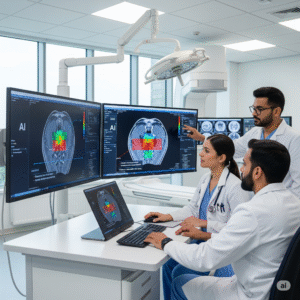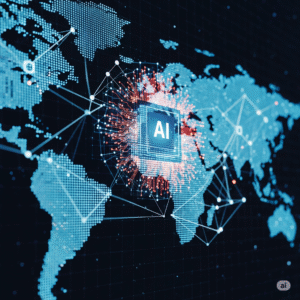Throughout history, progress has been defined by the tools that extend our senses. The telescope revealed the cosmos, the microscope uncovered unseen worlds, and the particle accelerator unveiled the fundamental building blocks of matter. Today, we stand at the dawn of a new era, armed with a tool that extends not our senses, but our intellect: Artificial Intelligence. We are witnessing the rise of AI scientific research, a paradigm shift that is fundamentally reshaping how we ask questions, analyze data, and make groundbreaking discoveries.
The modern scientist faces a challenge of scale—a “data deluge.” From genomic sequencers generating terabytes of data daily to climate sensors blanketing the globe, we are collecting information at a pace far exceeding our capacity for manual analysis. In this sea of data lie the answers to humanity’s most pressing questions, but finding them is like searching for a single molecule in an ocean.
This is where AI steps in. It serves as a new kind of analytical engine, capable of sifting through unprecedented volumes of data to identify subtle patterns, generate novel hypotheses, and accelerate the cycle of discovery at a blistering pace. This guide explores the transformative impact of AI scientific research, moving beyond the hype to showcase its real-world applications, essential tools, and the incredible future it promises.
What is AI Scientific Research? Beyond Simple Automation
When we talk about AI scientific research, it’s easy to think of it as simple automation—a robot performing repetitive lab tasks. But its true potential is far more profound. It represents a suite of advanced computational techniques, including machine learning (ML), natural language processing (NLP), and computer vision, that work in concert to augment human intelligence.
Unlike traditional methods that rely on researchers to form a hypothesis and then test it, AI can analyze a dataset and generate hypotheses on its own. It can read and synthesize millions of research papers in minutes, connect disparate fields of study, and build predictive models of staggering complexity. The goal of this new approach to research isn’t to replace the scientist but to empower them, freeing them from the drudgery of data wrangling and allowing them to focus on what they do best: critical thinking, creativity, and asking the big questions. This collaborative approach is the heart of the modern AI scientific research movement.
Core Applications: Where AI Scientific Research is Making an Impact
The impact of AI is not confined to a single field; it is a tidal wave washing over the entire landscape of science. From medicine to materials, AI is already solving problems that were once considered intractable, proving its value in a diverse range of disciplines.
Accelerating Drug Discovery and Genomics
Perhaps the most mature application of AI scientific research is in biology and medicine. The process of discovering a new drug is notoriously long and expensive. AI dramatically shortens this timeline by predicting how different molecules will interact with proteins in the body, identifying promising drug candidates from virtual libraries of billions of compounds. This focus on targeted discovery is making personalized medicine a tangible reality.
Decoding Climate Change and Earth Sciences
Understanding our planet’s complex climate system is a monumental data challenge. AI algorithms are now being deployed to analyze vast datasets from satellites, ocean buoys, and weather stations. These models can predict extreme weather events with greater accuracy, identify the drivers of deforestation from satellite imagery, and simulate the long-term effects of climate change, providing policymakers with the critical insights needed to take action. This is a vital area of active AI scientific research.
Revolutionizing Material Science and Engineering
Imagine discovering a new material for a hyper-efficient solar panel or a stronger, lighter alloy for aerospace—not by chance, but by design. AI is making this possible by running complex simulations to predict the properties of novel materials before they are ever synthesized in a lab. This “in silico” approach accelerates the discovery of new materials with tailored properties, promising innovations across countless industries.
Case Studies in Action: Real-World Examples of AI Scientific Research
The promise of AI isn’t theoretical. It’s already delivering breakthroughs that are reshaping our world.
Case Study 1: DeepMind’s AlphaFold Solves a 50-Year-Old Grand Challenge
The Challenge: For half a century, one of the biggest challenges in biology was the “protein folding problem”—predicting the complex 3D shape of a protein from its one-dimensional sequence of amino acids. Solving this was key to understanding diseases and designing new drugs.
The Solution: Google’s AI lab, DeepMind, developed AlphaFold, a revolutionary AI system. By training on a vast database of known protein structures, the AI learned the complex physical rules governing how they fold.
The Result: As reported in the prestigious journal Nature, AlphaFold can now predict protein structures with an accuracy that rivals laborious experimental methods. DeepMind has made its database of over 200 million protein structures freely available, single-handedly revolutionizing structural biology and supercharging AI scientific research in drug discovery worldwide.
Case Study 2: The Allen Institute for AI (AI2) Streamlines Knowledge
The Challenge: The sheer volume of published scientific literature makes it impossible for any human to keep up. A researcher might spend weeks or months on literature review, and could still miss a critical connection in another field.
The Solution: AI2, a non-profit research institute, created Semantic Scholar. It’s not just a search engine; it’s an AI-powered discovery tool. It uses natural language processing to read papers, summarize their key findings, and map out the web of citations to identify influential research.
The Result: Semantic Scholar is now used by millions of researchers. It drastically cuts down on literature review time and, more importantly, helps scientists discover relevant papers and authors they would have never found otherwise, fostering cross-disciplinary collaboration and sparking new ideas.
Essential Data Analysis AI Tools for Modern Researchers
For scientists eager to integrate AI into their work, a growing ecosystem of powerful data analysis AI tools is available. Many are surprisingly accessible and don’t require a PhD in computer science to use.
- For Data Visualization and Exploration: Tableau or Microsoft Power BI
- These business intelligence platforms have powerful, user-friendly AI features. Researchers can drag and drop massive datasets and use AI-driven functions to automatically spot trends, identify outliers, and create compelling visualizations without writing a single line of code.
- For Literature Review and Synthesis: ChatGPT
- Generative AI models like ChatGPT are becoming indispensable research assistants. A scientist can paste the abstract of a complex paper and ask for a summary in plain language, brainstorm potential research questions, or even get help drafting an outline for their own paper.
- For Custom Modeling and Analysis: Open-Source Libraries
- For those with programming skills, libraries like Google’s TensorFlow and Meta’s PyTorch provide the building blocks to create custom machine learning models tailored to a specific AI scientific research problem, offering maximum flexibility and power.
A Beginner’s Workflow for Implementing AI Scientific Research
Getting started with AI can feel intimidating, but a structured approach can make it manageable.
- Define a Clear, Narrow Question: AI thrives on specific problems. Instead of “analyze my data,” frame it as “predict which of these 1,000 compounds is most likely to bind to this protein.”
- Gather and Clean Your Data: This is the most critical step. The principle of “garbage in, garbage out” is paramount in AI. As data experts at HubSpot frequently note, data quality is the foundation of any successful analysis. Ensure your data is accurate, complete, and well-formatted.
- Select the Right Tool for the Job: Match the tool to your task. Need to explore data visually? Start with Tableau. Need to process thousands of text documents? Look into NLP libraries.
- Start with a Pilot Project: Don’t try to boil the ocean. Select a small, manageable subset of your data and test your chosen AI tool. This helps you understand its capabilities and limitations before committing to a large-scale project.
- Interpret, Validate, and Iterate: Remember, AI is a tool for generating hypotheses, not truth. The researcher’s expertise is crucial for interpreting the results, validating them with real-world experiments, and using the findings to refine the next round of analysis.
- ASC Structure for Maximum E-commerce Scale
Conclusion: A New Partnership in Discovery
The integration of AI scientific research is not merely an incremental improvement; it is a fundamental transformation of the scientific method itself. We are moving from a world where discovery is limited by human hours and cognitive capacity to one where it is accelerated by the near-infinite processing power of AI.
This new frontier calls for a new kind of scientist—one who is not only an expert in their domain but also adept at collaborating with intelligent systems. The partnership between tireless, data-driven AI and curious, creative human researchers is poised to unlock discoveries we can currently only dream of, solving our world’s most complex challenges and ushering in an unprecedented era of progress.
Advantage+ Shopping Campaigns: Supercharge Your E-commerce Sales



